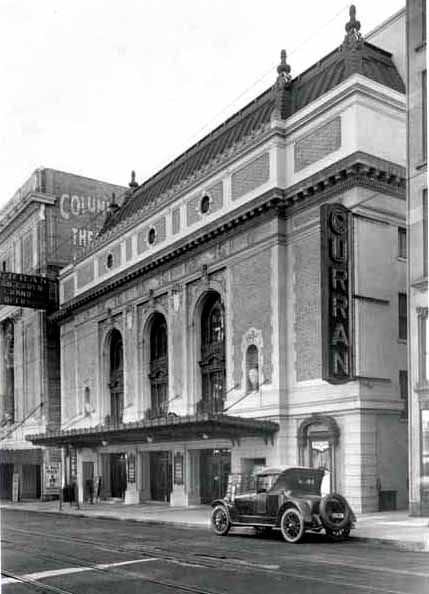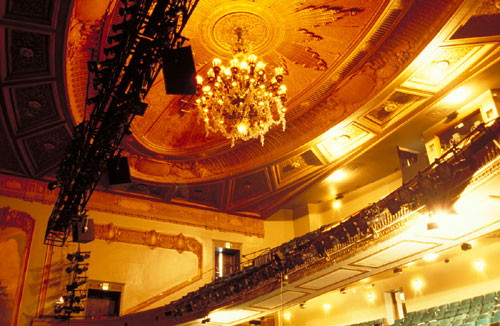Curran Theatre
445 Geary Street / San Francisco, CA 94102


The Curran was built at a cost of $800,000 by Curran and Schubert
and opened on September 10, 1922.
Alfred Henry Jacobs (1882-1954, a Jewish architect
who designed some of the first movie palaces and
many important homes and businesses in the
San Francisco Bay Area) was the architect.

Curran Theatre - 1920s
The Curran Theatre is named after its first owner, Homer Curran,
and its design is thought to be based on six Broadway theatres,
making it one of the few non-New York theatres to be so similar
to Broadway venues in style.
(Homer Curran is also noted for writing the book for the musical "Song of Norway" and co-writing the book for the less-successful "Magdalena". He eventually left San Francisco for southern California where he rented theatrical lighting.)

Curran operated another theatre with his name for several years prior to building this theatre; however, the original Curran Theatre had various names before and after that time whereas this current theatre has never had another name.
It opened in February 1922 and was initially considered a Shubert circuit house, and then a showcase for Theatre Guild presentations. Later it became associated with the Civic Light Opera (CLO) which also operated in Los Angeles. The CLO obtained numerous prestigious bookings as well as producing their own shows (often with star names as the leads).

The ceiling above the main lobby is notable because it was handpainted to look like wood (steel wool was used to fashion a wood grain in the plaster before painting). The main lobby has a marble floor but has long since been covered by carpeting. It is less comfortable to stand on marble, became slippery when it rained, and also made the lobby colder. There are "plugs" built into the lobby floor in which to insert stanchions from which theatre ropes were hung to section off the lobby. It is claimed that its neon sign was the first in San Francisco (which replaced the original Curran sign consisting of lightbulbs).
The loge section was modified prior to "Hello, Dolly!"'s first booking at the theatre. Originally, the loge section was similar to the boxes with moveable chairs in sectioned areas. The box-like loges are still evident by what remains of the metal railings in front of the loge section as well as the decorative plaster when viewed from below. The change was made because it increased the seating capacity by about 10 seats in this highly desirable area. The interior main floor lobby no longer exists. Originally, it was changed to a minor degree to accommodate the installation of a sound booth without decreasing the Orchestra seating capacity. Eventually, the lobby space was used to install a larger bar area as well as handicap accessible restrooms.

Up until the mid-1990s, the auditorium used to be much more illuminated. There are two murals in the auditorium that are little-noticed without the enhanced lighting. Both rise from the lower mezzanine level on each side.

The theatre has two front curtains: the decorative green fire curtain in front of a gold curtain. When musicals traditionally utilized each theatre's front curtains, the first curtain would be raised five minutes prior to the start of the show. There were two coat check rooms: one off to the south of the main floor interior lobby and the other on the balcony (adjacent the ladies' restroom). There were also two telephone "booths" on the mezzanine lobby—one on each side of the windows. These booths were actually very small rooms with formal doors. The coat check rooms and telephone booths are now used for storage. The theatre also had a central vacuum system. This system is still evident by the connection points on the walls, near the floor. The chandelier was built in San Francisco (by a company that used to be on Mission Street). There is a plaque honoring Arthur Mayer mounted at the entrance to boxes L-M-N. Mayer watched the theatre being built, was hired by Curran as part of the theatre's opening night staff, and continued working at the theatre until he was nearly 100-years old.

In 1977, the Civic Light Opera shifted its operations to the Orpheum Theatre and, by the end of that year, Carole Shorenstein Hays and James M. Nederlander took over the operation of the Curran and launched their Best of Broadway season starting with John Raitt in the national tour of Shenandoah and including the west coast debut of Annie. Later, Shorenstein, a Tony award winning producer, changed the name of her organization, SHN (Theatres), and has operated the Curran as the premier theatre destination on the West Coast.

In the 1950s, the theatre was used for the interior and exterior scenes of a Broadway theatre in the movie All About Eve. The original main floor interior lobby can be seen in this film. All the theatre scenes were filmed at the Curran except for the dressing room interior. The television series, The Streets of San Francisco, filmed an episode inside and outside the Curran. In the program, the Curran is used as the setting for A.C.T. In reality, A.C.T. operates at the adjacent Geary Theatre which is also visible in some shots.
Luminaries such as Lenny Bruce, Mary Martin, Katharine Hepburn, Rex Harrison, Richard Taylor, Ian McKellen, Florence Henderson, Angela Lansbury, Mae West, Dorothy Loudon, Richard Kiley, Sally Ann Howe, Keene Curtis, Victor Garber, Laurence Luckinbill, Lucie Arnaz, Patti LaBelle, Rob Marshall, Georgia Brown, Ben Harney, The Smothers Brothers, Jane Connell, Ricardo Montalban, Werner Klemperer, Ethel Waters, Jean Fenn, Agnes Moorehead, Herb Edelman, Matthew Broderick, Joyce Van Patten, Elizabeth Franz, Jonathan Silverman, Zeljko Ivanek, Marcel Marceau, Ann Miller, Mickey Rooney, Judy Garland, Joel Grey, Florence Lacey, Ron Holgate, Lee Roy Reams, Paxton Whitehead, Ann Jillian, Leslie Uggams, Andrea McArdle, Mary Alice, Jack Lemmon, Estelle Parsons, Stacey Keach, Maxwell Caulfield, James Earl Jones, Karen Valentine, Brian Dennehy, Al Pacino, Amanda Plummer, Elizabeth Ashley, Mercedes McCambridge, Stockard Channing, Judith Light and many other stars have played at the Curran. Carol Channing not only played the Curran on mulitple occasions but also claimed it is where she saw first saw a stage show.

The SHN (Shorenstein Hays Nederlander) Curran, Golden Gate and Orpheum Theatres.
Programs available from this theatre:
The Lute Song / 1946
Kiss Me, Kate (San Francisco Civic Light Opera / 1955)
Cinema note: The legendary Lon Chaney's 1925 film version of “Phantom of the Opera”
was screened at the Curran Theatre.

![]()









